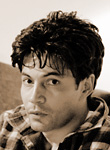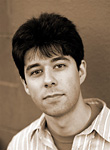|
INTRODUCTIONS: A READING LOOP
Dedicated to the memory of Thomas B. Gay, educator, painter, poet, friend.
(read more about Thomas B. Gay)
Each spring we use this reading loop to bring to your attention a group of writers and visual artists whose work you may be encountering for the first time. In this issue, the group includes several who have been published here before and have already made their way to other lists and anthologies acclaiming their remarkable work. We expect that you will be glad to discover them now—and to hear of them again later in their careers, as you no doubt will. We also dedicate Introductions to the memory of Thomas B. Gay, Richmond artist and writer and keen supporter of those beginning artists of any age or medium.
Sandra Beasley
Sandra Beasley dares to allow humor mixed with a delightfully sly wit into her poetry, marshalling those qualities in the service of a seriously inventive capacity for penetrating insight and sometimes rueful wisdom. Minotaurs, parades and college boys wear some striking new outfits in these poems and manage successfully to turn their old baggage to the task of gaining our compassion.
|
|
|
| |
|
|
Sami Ben Larbi
Sami Ben Larbi, in his Flash piece Three Parts Make A Hole, allows us a glimpse into the creation of a movie script. The words appear as if arriving straight from the hands of the writer. Ben Larbi’s work shows both the creation of ideas, and their correction, as the unseen hands destroy and recreate the words that will become the final movie. The multiple layers of narrative that Ben Larbi reveals echo the writing process and involves the viewer in the act of creation. |
 |
|
| |
|
|
Jehanne Dubrow
Jehanne Dubrow’s writing exhibits freely and imaginatively her identity among the “People of the Book” as well as her international upbringing, often in risk-taking and unexpected ways. Her “Nonexistent Yiddish Poet” has a tough mind, an aching heart, and a rare talent for image and language. These poems catch you in their sights and make you uncomfortable in their gaze.
|
|
|
| |
|
|
Terry Gibson
Terry Gibson’s play, Illinois, drops us in for drinks with a couple whom seem to be reflecting on that familiar Midwestern state in a way that puts it a bit closer to Harold Pinter’s neck of the woods than to Lake Michigan. Startling images and language hold our attention while we sort out where we stand in relation to our new acquaintances and our own state of mind.
|
|
|
| |
|
|
James Thomas Miller
James Thomas Miller knocks out poems which are distinctly Southern-fried, energetically self-critical, sarcastically cinematic, musically soaked in blues and funk, and unapologetically narrative, even if the narrative explodes like a loaded postmodern cigar. Clint Eastwood and King Elvis himself make appearances, and language makes the jump-cuts and slow dissolves that flicker on a screen the poet situates slyly in our mind’s eye.
|
|
|
| |
|
|
Miroslav Penkov
Miroslav Penkov calls on his Bulgarian heritage to land us in a story that marries folk tale to realistic narrative and the fantastic to the detailed mundane. Grounded in the intimacy of an oral transmission around a fire, the story also traverses that shaky ground where humor and broad comedy meet affection and earned sympathy. The narrator carries us with him on a short run through picaresque by-lanes that is definitely worth the trip.
|
 |
|
| |
|
|
Introductions texts appear in different
sections of Blackbird but are organized in this alternative menu, a
featured reading loop allowing easy navigation of the material.
An Introductions menu link appears at the bottom of every Introductions-related
page. You may also return to this menu at any time by visiting Features.
|